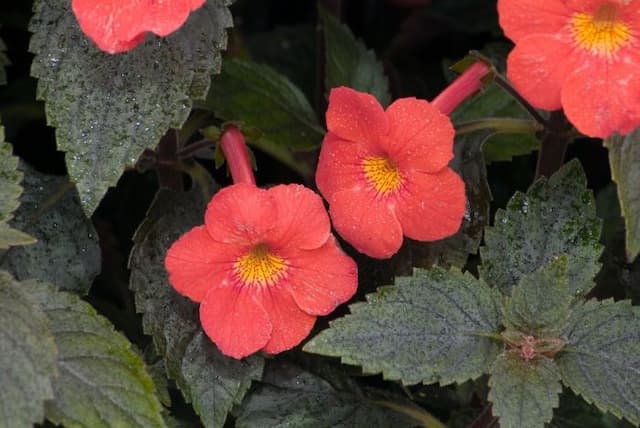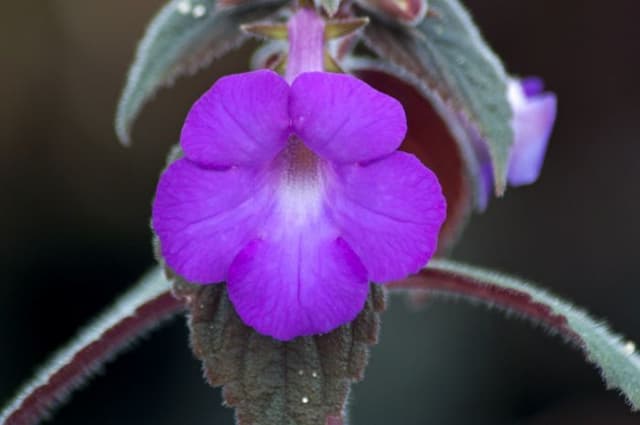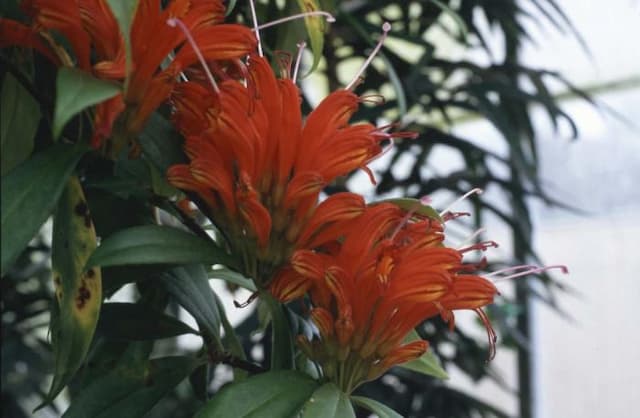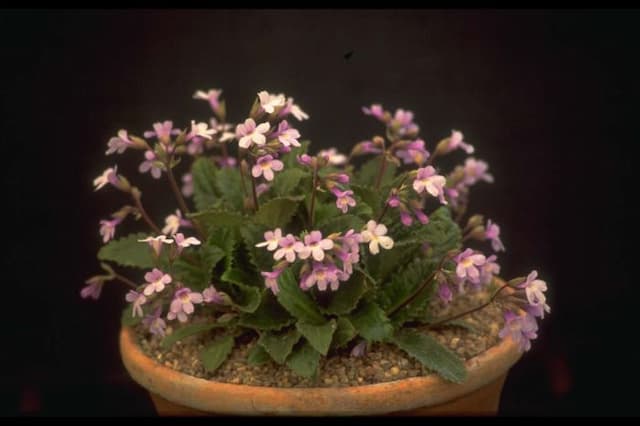Cape primrose 'Kim' Streptocarpus 'Kim'

ABOUT
'Kim' grows to 20cm, with large, oblong, hairy leaves and loose sprays of white-throated, deep violet-blue flowers 3.5cm across
About this plant
 Names
NamesSynonyms
Cape Primrose, African Violet.
Common names
Streptocarpus 'Kim'.
 Characteristics
CharacteristicsLife cycle
Perennials
Foliage type
Evergreen
Color of leaves
Green
Flower color
Varies
Height
6 inches (15 centimeters)
Spread
12 inches (30 centimeters)
Plant type
Herb
Hardiness zones
10
Native area
Africa
Benefits
 General Benefits
General Benefits- Easy to Care For: Streptocarpus 'Kim' is known for being low-maintenance and easy to grow, which makes it suitable for beginner gardeners.
- Aesthetic Appeal: The plant features attractive, velvety foliage and vibrant flowers that can add color and beauty to any indoor space.
- Long Blooming Period: It has a long flowering season, often blooming for several months, providing continuous visual interest.
- Compact Size: Its smaller size makes it ideal for indoor spaces such as windowsills and tabletops without taking too much space.
- Adaptability: Streptocarpus 'Kim' can adapt to a variety of lighting conditions, although it prefers bright, indirect light.
- Variety of Colors: The flowers come in a range of colors, which can complement any décor or color scheme.
- Propagation: It can be easily propagated through leaf cuttings, making it simple to create new plants for gifts or expanding your own collection.
 Medical Properties
Medical PropertiesThis plant is not used for medical purposes.
 Air-purifying Qualities
Air-purifying QualitiesThis plant is not specifically known for air purifying qualities.
 Other Uses
Other Uses- Photography Subject: The Streptocarpus 'Kim', with its vibrant blooms, can be an excellent subject for macro photography, allowing photographers to capture the intricate details of its flowers.
- Educational Tool: Botany teachers may use the plant to help students learn about the characteristics of the Gesneriaceae family and its reproductive biology.
- Greeting Cards: Images of the Cape primrose can be printed on greeting cards for an elegant natural touch due to their aesthetic appeal.
- Art Inspiration: Artists might use the distinct flowers of Streptocarpus 'Kim' as inspiration for paintings, drawings, and textile designs.
- Horticultural Competitions: Gardeners can raise Streptocarpus 'Kim' to compete in flower shows and horticultural competitions for their unique variety and beauty.
- Home Décor: Live plants or cut flowers can be used for interior decoration, adding a touch of color and nature to a room.
- Theme Gardens: Streptocarpus 'Kim' can be incorporated into thematic gardens, such as a purple-themed garden or a Victorian-style garden.
- Craft Projects: The flowers can be pressed and used in craft projects like homemade bookmarks, stationery, or potpourri.
- Terrariums: Because of its smaller size and humidity preferences, the plant can be a good addition to terrariums with appropriate space and light conditions.
- Collectors' Item: Particular varieties of Streptocarpus, including 'Kim', can be sought after by plant collectors due to their unique characteristics and colors.
Interesting Facts
 Feng Shui
Feng ShuiThe Cape Primrose is not used in Feng Shui practice.
 Zodiac Sign Compitability
Zodiac Sign CompitabilityThe Cape Primrose is not used in astrology practice.
 Plant Symbolism
Plant Symbolism- Persistence and Resilience: Streptocarpus, commonly known as Cape Primrose, often symbolizes persistence and resilience as it can bloom in shaded environments where other plants may struggle.
- Hope and Renewal: The ability of the Cape Primrose to produce flowers almost continuously throughout the year can represent hope and the idea of renewal, reflecting the plant’s constant rejuvenation.
- Adaptability: Symbolic of adaptability due to its capacity to thrive in various indoor environments and conditions which mimics the plant's natural adaptability in its African habitat.
 Water
WaterCape Primrose should be watered when the top inch of soil feels dry to the touch. This might be roughly once a week, but will vary based on environmental factors like humidity and temperature. Water the plant thoroughly, pouring water directly onto the soil until it begins to run out of the bottom of the pot, indicating the soil is fully saturated. It's crucial not to let the plant sit in standing water, so any excess that collects in the saucer should be emptied shortly after watering. Generally, use about a pint of water for a standard 6-inch pot, adjusting as necessary for larger or smaller pots.
 Light
LightCape Primrose benefits from bright, indirect light without exposure to harsh midday sun. A north-facing or east-facing window is an excellent spot, providing the soft light this plant prefers. It can also thrive under fluorescent lights, making it suitable for office spaces or areas in a home that don't receive ample natural sunlight.
 Temperature
TemperatureCape Primrose thrives in temperatures between 60°F and 75°F and shouldn't be exposed to temperatures below 50°F. It prefers a stable environment without rapid temperature fluctuations. Protect your Cape Primrose from drafts and vents that could cause sudden changes in temperature.
 Pruning
PruningPruning Cape Primrose is mainly done to remove spent flowers and withered leaves, encouraging the plant to produce new growth and more blooms. Pinch off faded blooms and any yellowing leaves at their base. The best time to prune is immediately after a flowering cycle, which can help stimulate a new flush of blooms. Depending on the plant's growth, this may happen several times a year.
 Cleaning
CleaningAs needed
 Soil
SoilThe best soil mix for Cape Primrose (Streptocarpus 'Kim') is a well-draining mixture, such as one part peat moss, one part perlite, and one part loam. It is important that the mixture retains moisture without becoming waterlogged. A slightly acidic to neutral soil pH of 6.0 to 7.0 is preferable for the health and growth of the Cape Primrose.
 Repotting
RepottingCape Primrose should be repotted every 1-2 years or when it becomes root-bound. It's best to repot in the spring, which will provide fresh nutrients and encourage new growth. Always use fresh soil mix when repotting the Cape Primrose to ensure adequate drainage and prevent soil compaction.
 Humidity & Misting
Humidity & MistingCape Primrose (Streptocarpus 'Kim') thrives in moderate to high humidity levels, ideally between 50-60%. Consistent humidity is important for the plant's well-being, so using a humidifier or placing a tray of water near the plant will help maintain the desired humidity levels.
 Suitable locations
Suitable locationsIndoor
Keep in bright, indirect light; water when topsoil is dry.
Outdoor
Place in partial shade, protect from strong wind and frost.
Hardiness zone
10-11 USDA
 Life cycle
Life cycleThe Streptocarpus 'Kim', commonly known as Cape Primrose, begins its life cycle as a seed, typically sown in a well-draining soil mix where it will germinate under warm, moist conditions. Once the seed germinates, it enters the seedling stage, developing its first leaves and roots, and gradually matures into a young vegetative plant. During its vegetative growth, the plant produces large, textured leaves from a basal rosette and then transitions to the flowering stage, where it forms colorful tubular flowers that can bloom throughout the year indoors. After pollination occurs, the plant may produce small, dry seed capsules that, when ripe, split open (hence the genus name "Streptocarpus" meaning "twisted fruit") dispersing seeds for new plant growth. Throughout its life, which can span several years with proper care, the Cape Primrose will continue to produce new leaves and flowers, while older leaves will wither and die, requiring removal to maintain plant health and appearance. If conditions are favorable and the plant is well cared for, it can be propagated vegetatively through leaf cuttings to produce genetically identical offspring, thereby continuing its life cycle.
 Propogation
PropogationPropogation time
Spring to summer
One of the most popular methods of propagating a Streptocarpus 'Kim', also known as a Cape Primrose, is by leaf cuttings. This can be done at almost any time of the year, but the best time is usually during the plant's active growing season, which is spring and summer. To propagate by leaf cuttings, select a healthy, mature leaf and cut it into pieces, ensuring each piece has at least one vein. Place the leaf pieces right side up on a moistened mix of perlite and peat moss, pressing them into the surface. Cover the propagation tray with a clear plastic to maintain humidity and keep it in a warm, brightly lit area, avoiding direct sunlight. Roots typically develop within a few weeks to a couple of months, after which you can transplant them into individual pots to grow into new plants.









